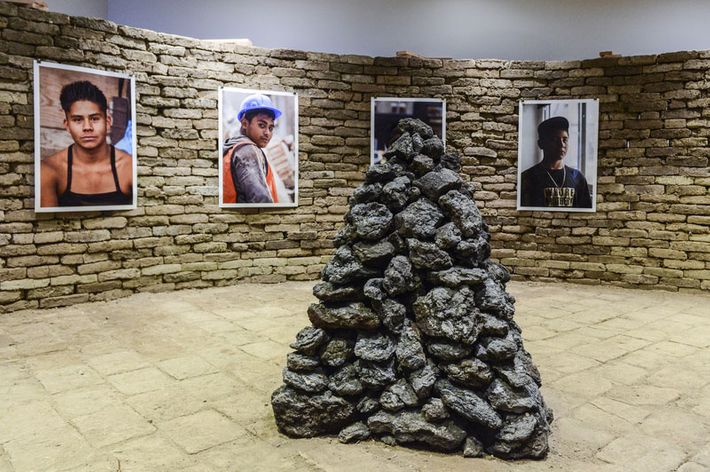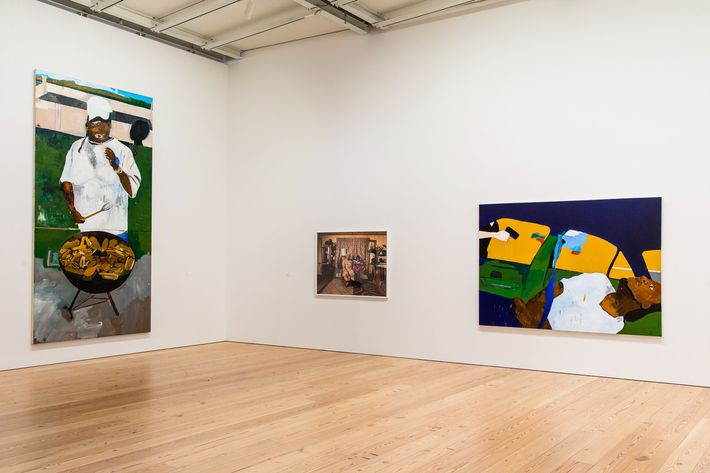
The 2017 Whitney Biennial got caught in an almost extinction-level political crosswind. Research and the selection for the show began in 2015 at the height of the Age of Obama, the apotheosis of the granular politics of identity and multiple subjectivities, systemic investigation into socioeconomic structures, biographies and autobiography, the rise of personal trauma narratives, and continual attempts to set historical records straight. This was to be the first biennial in a brand-new, beautiful downtown building dedicated to these progressive truths which the art world holds to be self-evident (and which Michelle Obama, in fact, had helped inaugurate). Half of the show is women and people of color; there are no art stars or heavy footprints of mega-galleries or the market. The arc of history was liberal.
Then on November 8, 2016, history jumped the track and we all found ourselves on the deck of a social-political Titanic. Thus, the 2017 Whitney Biennial was organized in one era and exists in another. I leadingly asked the show’s two 30-something Asian-American curators, Christopher Y. Lew and Mia Locks, if they altered anything after the election. Nodding with patient understanding but unshaken, both firmly said, “We didn’t change course.” By all rights then, this is the first, last, and only Hillary Clinton biennial.
But that doesn’t mean it is out of step, nice-y nice, disconnected, or just so many snowflakes from another era. Instead and pressingly, even with wild up and downs, flaws and all, the 2017 Whitney Biennial is the best of its kind in some time for the multiple ways it reveals how — selected as it is, without overdetermined political and aesthetic dogma, and curators remaining open to the exigencies of pleasure and the mysterious ways that art mutates but doesn’t play catch-up — a show of artists simply at work, whether making expressionistic paintings, idiosyncratic functional constructions, casting the further shores of socially activist conceptualism, or documenting collapsing ecosystems or family dynamics — that artists are always addressing and channeling issues of the day. With gravitas, grace, intensity.

Trump barely appears in this show. Although when he does, it’s strong, as in a handful of Oto Gillen’s great photographs of Trump rallies that pull back the curtain on intractable white-nationalist rage coming to a boil and the lacerating bliss of certainty in the faces of his supporters. In Rafa Esparza’s not-to-be-missed adobe-brick installation off the lobby are portraits of exactly the sort of so-called “Mexican rapists” and brown youth that Trump supporters rail against. He’s there in absentia in An-My Lê’s New Orleans photo dated November 9, 2016, of a brick building with graffiti that says “Fuck this racist asshole President.” Maybe he’s there in the work that people will argue about: Jordan Wolfson’s ultraviolent 90-second virtual-reality film that feels like a metaphor for the unfocused furor I gleaned at Trump rallies. I wondered if Trump was there, haunting the collective Postcommodity’s riling four-channel video of the border fences between Mexico and the United States.
And yet early whispers tell a different story. I went to three different press previews and each time a different critic whispered into my ear that he or she thought the politics in the show might be “unfocused” and “soft.” Each time I cringed a little, felt defensive and even protective of the art here and of art in general now widely being called on to instantly and effectively address the politics of the moment. To those who charge that this show’s politics are unfocused or soft, I’ll step on a soapbox to say the 2017 is the most politically charged since the 1993 Biennial. It is multi-themed, serious, and feels like there are things at stake. Better, its politics are not just present in its subject matter. Artists aren’t just shoving references to Trump in their art or writing out long explanations how this has to do with him; instead, they’re embedding their politics within the work so that anyone who comes to it — not just artsy insiders who know the buzzwords and read the postmodern references — may glean art’s power if they invest some effort. Nothing in this show reveals itself too quickly.
What does that mean? Almost a quarter of a century on from the marker laid down by the ’93 Biennial, artists are now transforming and transubstantiating politics into materials and form. We are already awash in bad Trump art, images of the president put to cheap use; we don’t need more work like that. Instead, how about work that’s more subtle, less easy, more complicatedly strange? This is everywhere in this show. Consider Frances Stark’s great series of wonky text paintings that call for censorship of talk radio, politicians, newscasts, and the free press — a totalitarian argument that suddenly appeals until you think about it for more than one second. Or Kaari Upson’s unusable, twisted cast couches that look like abstract gargoyles from Notre Dame, and Jessi Reaves’s surgically reconstructed, functional couches and chairs that cross Cronenberg and Nauman; both artists let you know that big ideas about art, culture, form, materials, and psychic infrastructure are under the knife. Both artists use no didacticism or dogma to deliver their messages, and whatever messages that are delivered are paradoxical. Leigh Ledare’s three film loops were made last year around Moscow train stations. In them, we see a possible ghost of America’s near future — people under autocratic rule, made numb, hailing from numerous social and racial strata, all barely interacting; the broken, homeless, and addicted existing but invisible alongside state workers, the wealthy, figures fighting, mothers helping their children go to the bathroom against walls. I saw a possible America in this almost animal society, its political house on fire.
I raised the issue of critics saying that this Biennial is politics-lite to participant Jon Kessler, who has two DIY Neolithic techno-moving structures about the imminent effects of global warming, rising sea levels, and the near-future evacuation of hundreds of millions of people from the coasts, and who, as a longtime teacher at Columbia, has been a touchstone for eight (!) of the 63 artists on view. When I asked him if he felt like the politics in this show were outdated, he looked at me steadily, incredulously, as if he’d been patrolling some psychic border for centuries and said, “Jerry, I’ve been pissed off about all this since the 2000 election. So have all the artists I know.” Amen.
The perfect metaphor for this show hangs behind the museum ticket takers, where detailed directional notices are usually available. In their place are two large, blank, brown highway signs by Park McArthur. The message, to me, was clear: With no instructions to guide us, and maybe no natural or cultural destinations remaining, we’re the ones who are going to have to make our way on from here. That’s deep politics.

How else is this show different from its recent predecessors? The last edition found three outside curators each doing his or her own show, installing each show separately. That’s out. Here everything’s integrated and spaciously installed (a first?) — even if sometimes on the fifth floor your ears throb from overlapping sound installations. No matter, there aren’t any self-cannibalizing theories or academic clubs beating you on wall labels. There’s almost no art here based on pop culture or mainstream fashion and design, and you won’t find high production values or ideas of a postmodern theory and identity as a matrix formed by many different texts (all of which have been staples of the last 35 years, and suddenly staid seeming). Not one essay quotes any of the usual postmodern theoretical suspects for authority. Indeed, these curators risk getting kicked off Theory Island in their essays talking about “earnestness, honesty, not being ironic but being sincere, spirituality, personhood, intimate relationships, not being motivated by careers, and a certain modesty or humility.” One even quotes Emerson. Take it from someone who’s spent accumulated alienated months trying to read densely worded wall labels and heady essays, these biennial cattle calls don’t usually roll this way. I love it.
I’d suggest starting on the fifth floor. Here, prominently, is painting, the medium that almost dared not speak its name in recent big international shows. And it looks very strong— unapologetic, veering from abstract to representational, not process-based or made-for-curator zombie-minimalistic. This is the first Biennial in a long time where color and painterly materiality are in constant evidence. The 40-year-old wunder-painter Dana Schutz — who launched a hundred careers with her own wild work but who, since her exuberant emergence in 2002, proved too untamed for all other Biennial curators — here unleashes three unspeakably vibrant new works which really up her painterly game. If you think her work isn’t “political enough” see her thick, sluicing Open Casket, based on a portrait of slain teenage civil-rights martyr Emmett Till and see if the idea of Black Lives Mattering doesn’t crash in on you. And her gigantic Elevator, a crazy Picassoesque broken field of bodies, insects, a great white looming hand, high heels, and blonde hair somehow evokes the infamous words of our president: “I moved on her like a bitch.”
On the sixth floor the great Henry Taylor gives us a history-scale painting of a black horseman. Like Schutz and the other painters on hand (only Tala Madani deals blatantly with sex) he shows us that painting isn’t atavistic or elitist, that anyone may access it, that it is still an incredibly effective human invention for making one’s inner abstract ideas visible in two dimensions, and that it never exhausts its vast bag of visual, material, chromatic, and subject matter tricks. Don’t miss Taylor’s own stark “Death of Marat” moment in a painting of Philando Castile being fatally shot by a Minnesota police officer in 2016 and captured by his girlfriend Diamond Reynolds, and tell me you don’t remember her howling sounds as she witnesses the event. Then try to call the Biennial soft.
Much of the work in this show gives us artists who aren’t abandoning irony or even cynicism, but who are weaponizing these psychological structures in almost Shakespearean ways in order to address shapeless ideas of hate crimes, anger, malicious injustice, a white wolflike tribe adjusting to psychic servitude before a charismatic leader who could “stand in the middle of Fifth Avenue and shoot somebody” and not lose any voters.
Meditations on economic disparity and concentrated wealth also run through the show — a notable sign of radical feeling, given how dependent the art world is on the wealthy for patronage. But just gawk at Samara Golden’s dizzying showstopper, The Meat Grinder’s Iron Clothes, a simple but labor-intensive hall of mirrors installation that imparts an endless optical illusion of the interior of a skyscraper going Jack and the Beanstalk high and descending infernally into the earth. (This Kafkaesque or Boschian structure seems to house laboratories, beauty salons, bathrooms, crash pads, waiting rooms, gyms, bedrooms, wheelchairs, restaurants, and work stations.) Then take in Anicka Yi’s breathtaking 3-D film The Flavor Genome, which tracks a “prospecting mission in the Brazilian Amazon: a hunt for a mythical plant.” She adds another beautiful layer to W. G. Sebald, Werner Herzog, and Borges dealing with the disappearing secrets of ecological destruction.
All this leads me to answer people who ask me, “How’s the 2017 Whitney?” with the word “Pertinent.” This isn’t damning. It’s important.
D.H. Lawrence wrote that America “is deathly sick with saviourism.” This sickness has infected our politics. Right now art simply needs to do what it does best. That is, continue, in the words of Lawrence, by “pioneering into the wilderness of unopened life.”
*A version of this article appears in the March 20, 2017, issue of New York Magazine.

